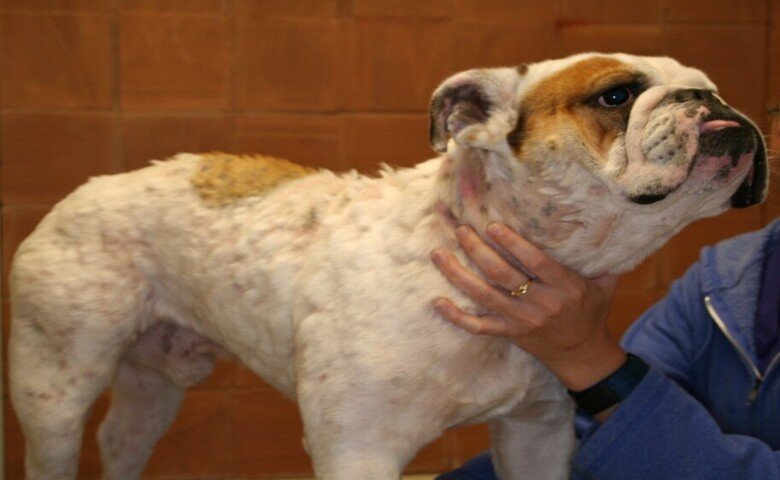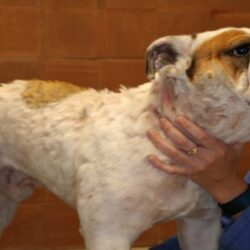Pyoderma in dogs is a common skin infection caused by bacteria. It can occur on any part of the dog’s body and is characterized by redness, inflammation, and the formation of pustules or pus-filled bumps on the skin. Effective pyoderma in dogs home treatment involves keeping the affected area clean and dry, using topical treatments, and ensuring proper nutrition and hygiene.
While pyoderma in dogs home treatment for can be helpful in managing the condition, it is important to consult with a veterinarian for accurate diagnosis and a comprehensive treatment plan.
Table of Contents
What is Pyoderma in Dogs?
Pyoderma in dogs is a common skin infection caused by bacteria. It is characterized by the presence of pustules or pus-filled bumps on the skin, along with redness, inflammation, itching, and sometimes a foul odor. Pyoderma can occur on any part of the dog’s body and can range from a superficial infection affecting the top layers of the skin to a deeper infection that affects the deeper layers of the skin.
There are different types of pyoderma in dogs, including superficial pyoderma, deep pyoderma, and interdigital pyoderma.
Superficial pyoderma is the most common type and is usually caused by bacteria such as Staphylococcus intermedius. It typically affects the top layers of the skin and can be easily treated with appropriate antibiotics.
Deep pyoderma, affects the deeper layers of the skin and can be more challenging to treat. Interdigital pyoderma specifically affects the spaces between the toes and is often caused by excessive moisture or allergies.
What Causes Pyoderma in Dogs?
Pyoderma in dogs is a skin infection that can be caused by various factors. Some common causes of pyoderma in dogs include:
Bacterial overgrowth: Pyoderma often occurs when there is an overgrowth of bacteria on the skin. This can happen due to a weakened immune system, allergies, or underlying health conditions.
Allergies: Dogs with allergies, such as food allergies or environmental allergies, are more prone to developing pyoderma. Allergies can cause itching and scratching, which can lead to breaks in the skin and bacterial infection.
Fleas and ticks: Infestations of fleas and ticks can cause irritation and itching, leading to pyoderma. These parasites can also introduce bacteria into the dog’s skin, causing an infection.
Moisture and humidity: Dogs that are constantly exposed to moisture or live in humid environments are more susceptible to pyoderma. Moisture can create an ideal breeding ground for bacteria, leading to infection.
Poor grooming: Dogs that are not regularly groomed or have matted fur are more prone to developing pyoderma. Mats and tangles can trap moisture and bacteria close to the skin, increasing the risk of infection.
Skin folds: Breeds with skin folds, such as Bulldogs or Shar-Peis, are more susceptible to pyoderma. The folds can trap moisture and bacteria, leading to infection.
Trauma or injury: Any break in the skin, such as a scratch, cut, or scrape, can provide an entry point for bacteria, leading to pyoderma.
Pyoderma in Dogs Symptoms
Pyoderma in dogs refers to a bacterial skin infection that can cause a variety of symptoms. Some common symptoms of pyoderma in dogs include:
Redness and inflammation of the skin: The affected area may appear red, swollen, and irritated.
Itching and scratching: Dogs with pyoderma often experience intense itching, leading to excessive scratching and licking of the affected area.
Pustules and pimples: Small, pus-filled bumps may develop on the skin, resembling pimples or pustules. These can break open and form crusts.
Hair loss: Due to the constant scratching and licking, hair loss may occur in the affected area.
Bad odor: Pyoderma can cause a foul smell due to the presence of bacteria on the skin.
Pain and discomfort: Dogs with pyoderma may exhibit signs of discomfort, such as reluctance to be touched or sensitivity in the affected area.
Secondary infections: If left untreated, pyoderma can lead to more severe infections, such as cellulitis or abscesses.
Pyoderma in Dogs Home Treatment
While it is always recommended to consult with a veterinarian for proper diagnosis and treatment of pyoderma in dogs, there are some home care measures that can help alleviate symptoms and support the healing process. However, it is important to note that these home treatments should not replace veterinary care and should only be used as a temporary measure until you can seek professional advice.
Keep the affected area clean: Gently clean the affected area with a mild, pet-safe antiseptic solution or a diluted chlorhexidine solution. Avoid using harsh soaps or human products, as they can further irritate the skin.
Apply warm compresses: Soak a clean cloth in warm water and gently apply it to the affected area for a few minutes. This can help soothe inflammation and promote healing.
Keep the area dry: Moisture can worsen pyoderma, so make sure to keep the affected area as dry as possible. Avoid allowing your dog to swim or get wet in areas where the infection is present.
Prevent licking and scratching: Use an Elizabethan collar or a doggie onesie to prevent your dog from licking or scratching the affected area. This will help prevent further irritation and potential infection.
Dietary changes: A balanced and nutritious diet can support your dog’s immune system and overall skin health. Consult with your veterinarian to ensure your dog is receiving the appropriate diet for their specific needs.
Supplements: Some supplements, such as omega-3 fatty acids, can help improve skin health and reduce inflammation. Consult with your veterinarian before adding any supplements to your dog’s diet.
How to Prevent Pyoderma in Dogs
To prevent pyoderma in dogs, there are several steps you can take:
Maintain good hygiene: Regularly bathe your dog using a gentle, dog-specific shampoo. Be sure to thoroughly dry your dog’s coat after bathing to prevent moisture buildup.
Keep your dog’s skin and coat clean and dry: Regularly brush your dog’s coat to remove loose hair, dirt, and debris. Pay attention to areas with skin folds and make sure to keep them clean and dry.
Prevent and treat flea and tick infestations: Use appropriate flea and tick prevention methods recommended by your veterinarian. Regularly check your dog for fleas and ticks, and promptly remove any you find.
Address underlying health conditions: If your dog has allergies or any other underlying health conditions that can contribute to pyoderma, work with your veterinarian to manage and treat these conditions effectively.
Avoid excessive moisture and humidity: If your dog spends a lot of time in wet or humid environments, take steps to keep them dry. Use towels to dry your dog after walks in the rain or swimming, and provide a dry and well-ventilated living environment.
Maintain a healthy diet: Feed your dog a balanced and nutritious diet to support a strong immune system and overall skin health.
Regular veterinary check-ups: Schedule regular check-ups with your veterinarian to monitor your dog’s overall health and catch any potential issues early on.
How to Treat Pyoderma in Dogs Effectively
The treatment of pyoderma in dogs typically involves a combination of medical interventions and management strategies. Here are some common approaches to treating pyoderma in dogs:
Antibiotics: Since pyoderma is a bacterial infection, antibiotics are usually prescribed to eliminate the bacteria. The specific antibiotic and duration of treatment will depend on the severity and type of infection. It is important to complete the full course of antibiotics as prescribed by the veterinarian.
Topical treatments: Depending on the extent and location of the infection, your veterinarian may recommend topical treatments such as medicated shampoos, sprays, or ointments. These can help reduce inflammation, control bacterial growth, and promote healing of the skin.
Cleaning and disinfection: Regular cleaning and disinfection of the affected area can help remove bacteria and prevent further infection. Your veterinarian may provide specific instructions on how to clean the area and recommend suitable products.
Addressing underlying causes: Pyoderma can be caused or exacerbated by underlying factors such as allergies, hormonal imbalances, or parasites. Identifying and addressing these underlying causes is important to prevent recurrence of the infection. Your veterinarian may recommend allergy testing, dietary changes, or other treatments as necessary.
Preventing self-trauma: It is important to prevent your dog from scratching or licking the affected area excessively, as this can worsen the infection and delay healing. The use of Elizabethan collars or other protective measures may be necessary to prevent self-trauma.
Follow-up care: Regular follow-up visits with your veterinarian are important to monitor the progress of treatment and make any necessary adjustments. They may recommend additional treatments or tests if needed.
Conclusion:
Pyoderma in dogs home treatment can be effective in managing the condition and promoting healing. By following a few simple steps, such as keeping the affected area clean and dry, using topical treatments, and ensuring proper nutrition and hygiene, pet owners can help alleviate symptoms and prevent the spread of infection. However, it is important to note that home treatment should not replace veterinary care, especially in severe or recurring cases of pyoderma. Consulting with a veterinarian is crucial to accurately diagnose the underlying cause of the condition and develop a comprehensive treatment plan.
Also Read: Gastritis in Dogs
Image credit: Yandex.com















